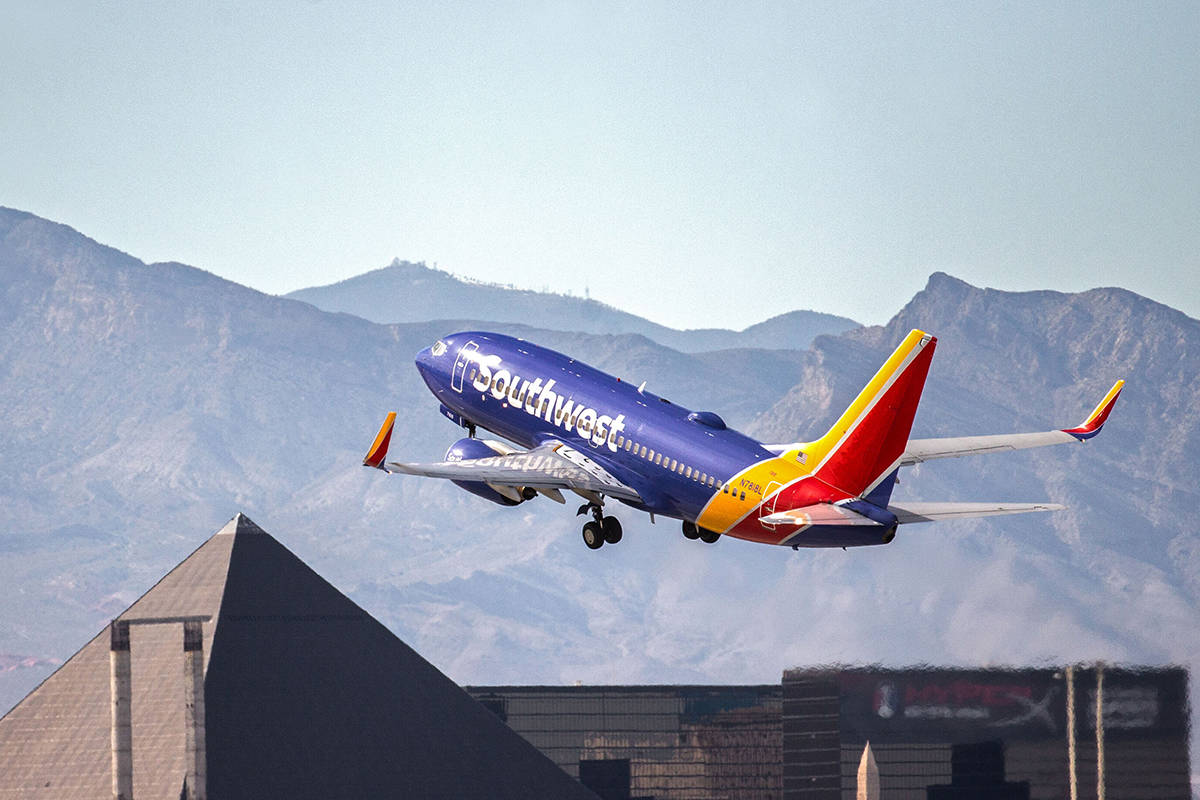Federal program helps keep Southwest profitable in 1Q
Southwest Airlines, a key conduit for returning leisure and business travelers to Southern Nevada after the pandemic, on Thursday reported improving results from January and February, but executives say they’re still a long way from normal operations.
The company would have lost more than $1 billion in the first quarter had it not been for a $1.2 billion offset of salaries, wages and benefits expenses from the federal government’s extended Payroll Support Program.
With the PSP contribution, Southwest reported net income of $116 million, 19 cents a share, on revenue of $2.052 billion for the quarter that ended March 31. That compares with a net loss of $94 million, 18 cents a share, on revenue of $4.234 billion for the first quarter of 2020 when the pandemic began affecting air travel.
“We think the worst is finally behind us,” Southwest Chairman and CEO Gary Kelly said in an earnings call with investors Thursday morning. “The payroll support from the federal government has allowed Southwest to preserve its 50-year history without involuntary layoffs or furloughs, an achievement unprecedented in the U.S. airline industry.”
Southwest has not laid off employees thanks to a voluntary separation and extended leave program, but due to increasing passenger demand and bookings, the company plans to increase flight activity in the summer.
Southwest is McCarran International Airport’s busiest commercial air carrier, and the airport has projected an increasing number of Southwest aircraft seats coming to Las Vegas.
McCarran has reported that 1.5 million seats a month on planes bound for Las Vegas was reported in April 2020. Today, Southwest provides 1.3 million seats. McCarran’s projections are for 1.5 million seats in June, 1.7 million seats in July and 1.8 million seats in August.
In February 2021, McCarran reported that Southwest flew 532,582 passengers to Las Vegas, 56.8 percent fewer than in February 2020.
Systemwide, Southwest hopes to operate at least 96 percent of its available seat miles by June, although the route structure is different than it was six months ago.
The company is in the midst of adding 17 new airport destinations, including Chicago’s O’Hare International Airport, Sarasota Bradenton International Airport in Florida, Colorado Springs Municipal Airport, Savannah-Hilton Head International Airport in South Carolina, Houston’s George Bush Intercontinental Airport, Bellingham, Washington International Airport, Eugene Airport in Oregon and Santa Barbara Airport in California.
Chief Operating Officer Mike Van de Ven told investors in the call that the new cities are performing better than managers had expected.
Among the new destinations coming up are Fresno Yosemite International Airport in California beginning Monday, Myrtle Beach International Airport on May 23 and Jackson-Medgar Wiley Evers International Airport in Mississippi and Bozeman Yellowstone International Airport in Montana starting June 6.
Van de Ven said of the new cities that have started up, “there’s not a clunker in the bunch.”
Kelly shared some concern about the return of business travelers — a major issue for casino companies that host meetings, conventions and trade shows.
The company, he said, is in the best position it’s ever been to accommodate business travelers. But, because many companies have re-examined business travel in the COVID-19 era and others have substituted technology and communicating online to in-person meetings, Kelly fears there could be a decline in business travel.
He said his research has shown that between 10 percent and 20 percent of business travel may have been lost permanently as a result of the pandemic.
Van de Ven said business travel hasn’t seen as strong a comeback as leisure travel, but that some companies are relaxing restrictions they’ve had.
Southwest has been able to expand by taking delivery of new Boeing 737 MAX jets. Some of those new jets will replace twin-engine Boeing 737-700s while others will be added to the fleet.
Between this year and 2031, Southwest has 200 firm orders for MAX 7 jets, 149 firm MAX 8 orders, with options on 270 MAX 7 or MAX 8 jets. With nine additional MAX 8s added this year, Southwest’s MAX fleet will total 628 within a decade.
Southwest stock, traded on the New York Stock Exchange, closed down 97 cents, 1.6 percent, to $61.07 a share in heavy trading Thursday.
This is a developing story. Check back for updates.
Contact Richard N. Velotta at rvelotta@reviewjournal.com or 702-477-3893. Follow @RickVelotta on Twitter.
Southwest Airlines Co.
First-quarter revenue and earnings for Dallas-based Southwest Airlines Co., the busiest commercial air carrier at McCarran International Airport. (NYSE: LUV)
Revenue
1Q 2021: $2.052 billion
1Q 2020: $4.234 billion
Change: -51.5%
Net income/(loss)
1Q 2021: $116 million
1Q 2020: ($94 million)
Earnings/(Loss) per share
1Q 2021: $0.19
1Q 2020: ($0.18)


















